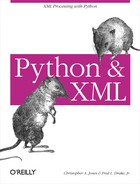XML Structure in a Nutshell
The basic structure of an XML document is simple. Most can be reduced to a few simple components. Consider the following:
<?xml version="1.0"?>
<PurchaseOrder>
<account refnum="2390094"/>
<item sku="33-993933" qty="4">
<name>Potato Smasher</name>
<description>Smash Potatoes like never before.</description>
</item>
</PurchaseOrder> In this example, the first line, starting with the
<? characters, is the
XML declaration. It states which version of XML is
being used and can also include information about the character encoding
of the document. The text starting with <PurchaseOrder> and ending with </PurchaseOrder> is an XML
element. An element must have an opening and
closing tag, or the opening tag must end with the
characters /> if it is to be
empty. The account element shown here
is an example of an empty element that ends with a
/>. The item element opens, contains two other
elements, and then closes. The sku="33-993933" expression is an
attribute named sku with its value 33-993933 in quotes. An element can have as
many attributes as needed. Both the name and description elements are followed by character
data or text. Finally, the elements are closed and the document
terminates.
In the remainder of this chapter, we walk through the relevant parts of the XML specification, highlighting the most important items for you to be aware of as you embark on coding with Python and XML.
